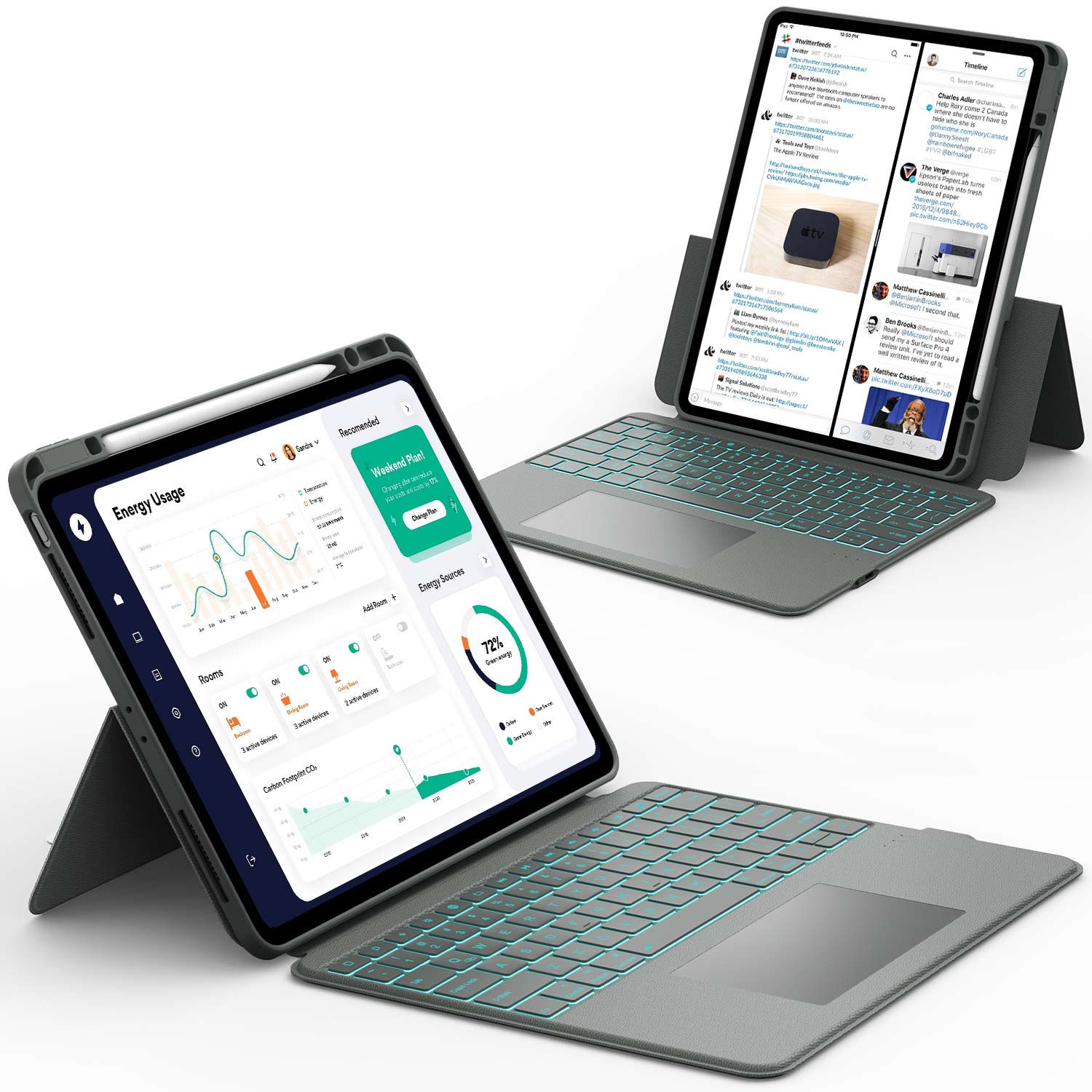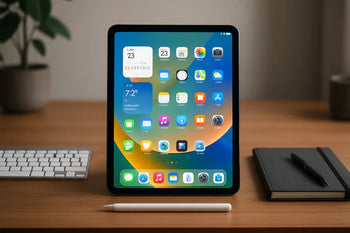Wondering how to get App Store back on iPad? When the icon suddenly disappears, it can feel like the App Store has been deleted. In reality, it’s usually just hidden by settings or restrictions.
The App Store is a built‑in app and can’t be permanently removed. With a few quick checks, it can be restored to the Home Screen in minutes.
This guide walks through the steps to bring the App Store back, explains why it sometimes disappears, and shares tips to keep an iPad running smoothly.
Restoring the App Store is a quick fix—keeping the iPad safe takes long‑term protection. Explore our iPad hard cases built for durability and everyday use.
Why The App Store Disappears On iPad

The App Store doesn't uninstall from your iPad, but certain settings or software issues can make it seem missing. Restrictions, hidden apps, or outdated iPadOS versions often cause this.
Restrictions Or Screen Time Settings
Screen Time lets you manage how apps work on your iPad. If the App Store disappears, it might be restricted under Content & Privacy Restrictions.
Check this by going to Settings > Screen Time > Content & Privacy Restrictions > iTunes & App Store Purchases. If “Installing Apps” is set to Don’t Allow, the App Store icon hides from your Home Screen.
People often use this for parental controls or to limit downloads. It can block access if you forget the Screen Time passcode or if settings change without you noticing.
Adjust the restriction to allow app installation, and the App Store should reappear. No need for a reset or update here.
Hiding Apps With Content Restrictions
Content restrictions can hide apps based on age ratings or allowed features. If your iPad blocks certain categories, the App Store may be hidden along with others.
In Settings > Screen Time > Content & Privacy Restrictions > Allowed Apps, you can toggle the App Store on or off. If disabled, the icon disappears from both the Home Screen and App Library.
This setting is common on shared devices, especially with kids. It sometimes causes confusion if the App Store vanishes without warning.
Make sure the App Store is marked as allowed. Since it's built into iPadOS, you never need to reinstall it.
Outdated iPadOS Or Software Glitches
An outdated iPadOS or a temporary glitch can also hide the App Store. Older systems, like iOS 14 or earlier, sometimes bug out and hide built‑in apps.
Check for updates in Settings > General > Software Update. Installing the latest version often brings back missing app icons.
If updating doesn't help, try Reset All Settings in Settings > General > Reset. This won't erase your data, but it restores system preferences and can fix misconfigured settings.
Sometimes, a restart or force restart clears up temporary glitches. If nothing works, a full reset of settings usually solves the issue. In rare cases, restoring the iPad through Finder or iTunes can refresh system apps.
How To Get App Store Back On iPad
If the App Store icon is missing, it's probably hidden, restricted, or moved somewhere unexpected. You can bring it back by tweaking settings, resetting your layout, updating your device, or restarting it.
Check Screen Time And Restrictions In Settings
Screen Time restrictions are the top reason the App Store disappears. These controls can block installing or deleting apps, hiding the App Store icon in the process.
Head to Settings > Screen Time > Content & Privacy Restrictions. Make sure restrictions are off or set to allow iTunes & App Store Purchases. If "Installing Apps" says Don’t Allow, you won't see the App Store anywhere.
Also check Allowed Apps under Content & Privacy Restrictions. If the App Store switch is off, turn it on. Then, use Spotlight Search by swiping down from the middle of the screen and typing App Store to see if it pops up.
Reset Home Screen Layout
If the App Store isn't restricted but you still can't find it, the icon might be buried in a folder or hidden across Home Screen pages. Resetting the layout puts all default apps back where they started.
Go to Settings > General > Transfer or Reset iPad > Reset > Reset Home Screen Layout. This won't delete your data or apps, just removes custom folders and arranges everything in default order.
After the reset, check the first Home Screen page. The App Store icon should be there. If you like using folders, you can reorganize after confirming the App Store is visible again.
Update iPadOS To The Latest Version
Sometimes, a missing App Store icon comes from software bugs. An outdated iPadOS can cause display issues or stop system apps from working right.
Go to Settings > General > Software Update. If an update is available, download and install it. Make sure your iPad is on Wi‑Fi and has enough battery, or plug it in.
Updating iPadOS helps keep built‑in apps like the App Store working. After the update, check both the Home Screen and App Library to see if the icon is back.
Restart Or Force Restart Your iPad
If the App Store still won't show up, try restarting your device. A normal restart usually does the trick, but sometimes a force restart is needed.
To restart, press and hold the Top button and either Volume button until the power slider appears. Slide to turn off, then press the Top button again to turn it back on.
For a force restart, quickly press and release Volume Up, then Volume Down, and hold the Top button until you see the Apple logo. This refreshes the system and might restore the App Store icon.
Once the App Store is back, downloading productivity apps is easier than ever. Pair them with our iPad case and Bluetooth keyboard for a complete mobile workstation.
Tips To Keep Your iPad Running Smoothly

Your iPad stays efficient and reliable if you keep up with software updates, check for restrictions, back up your data, and protect the device from damage. These steps help avoid slow performance, missing apps, and data loss.
Keep iOS Updated Regularly
Running the latest iOS version gives your iPad new security patches, bug fixes, and performance boosts. Updates also fix issues that can slow things down or make apps misbehave.
To check for updates, go to Settings > General > Software Update. If you see one, download and install it. Make sure you have enough battery or keep your iPad plugged in.
You can turn on Automatic Updates so your iPad installs new versions overnight while charging. That way, you don’t have to remember to check manually.
Apps need updates too. Outdated ones may crash or drain your battery. Open the App Store, tap your profile, and update your apps regularly.
Review Screen Time Restrictions Often
Screen Time settings can hide or block the App Store, Safari, or other apps. Restrictions from the past might still be active and limit what you can do.
Go to Settings > Screen Time > Content & Privacy Restrictions to see what’s enabled. Check if app installations are allowed and confirm that the App Store isn’t restricted.
It's a good idea to review these settings every few months, especially if more than one person uses the iPad. Kids’ accounts often have extra limits that affect downloads or app visibility.
If you forget the Screen Time passcode, you’ll need to reset it with your Apple ID. Keeping this info updated helps prevent unnecessary lockouts.
Back Up Your iPad Before Changes
Before installing updates, resetting settings, or making big changes, back up your iPad. A backup keeps your photos, documents, and app data safe if something goes wrong.
You can back up to iCloud or use a computer with Finder (macOS) or iTunes (Windows). iCloud backups run automatically if you enable them, while computer backups give you more control and storage.
Check your last backup in Settings > [your name] > iCloud > iCloud Backup. Tap Back Up Now if it hasn’t updated recently.
A current backup gives you peace of mind and lets you restore your iPad quickly if you ever need to.
Protect Your Device With A Durable Case
Physical damage is a common reason iPads stop working well. A durable case helps protect against drops, scratches, and pressure on the screen.
Look for cases with shock absorption, raised edges, and secure covers for the display. Rugged or leather cases add long‑lasting protection while keeping the iPad stylish and functional.
A well‑fitted case helps prevent scratches, cracks, and costly repairs, extending the life of the device.
A good case and screen protector won’t speed up your iPad, but they do help keep it working longer by protecting the hardware. Sometimes, these small steps save you from expensive repairs down the road.
A smooth iPad experience deserves stylish protection. Discover our leather iPad cases for a premium blend of elegance and durability.
Conclusion: How to Get App Store Back on iPad
Getting the App Store back on an iPad usually takes just a few quick fixes. Checking Screen Time restrictions, resetting the Home Screen layout, or updating iPadOS often solves the problem right away.
Since the App Store is built in, it never truly disappears — it only needs to be restored through the right settings. A little maintenance helps keep the device reliable and ready for everyday use.
For more ways to keep iPad software up to date and running smoothly, read our guide on how to update iPad.
Frequently Asked Questions: How to Get App Store Back on iPad
You can't remove the App Store from your iPad, but it can get hidden or restricted. This usually happens because of settings changes, parental controls, or software quirks that make the icon hard to find.
How do I get the App Store app back on my iPad?
Search for “App Store” with Spotlight or check the App Library. If it’s still missing, go to Settings > General > Reset > Reset Home Screen Layout. This restores the icon to its default spot.
Why is the App Store not available on my iPad?
Screen Time restrictions may be hiding it. Check Settings > Screen Time > Content & Privacy Restrictions > iTunes & App Store Purchases. If allowed, update iPadOS to the latest version.
How do you download the App Store if you deleted it?
The App Store can’t be deleted from an iPad. If it’s missing, it’s hidden or restricted. Resetting the Home Screen or turning off restrictions will bring it back.
Why does the App Store disappear?
Screen Time restrictions often cause it to vanish. Software glitches or setting changes can also hide the icon. Sometimes it’s just tucked away in a folder or App Library.



















